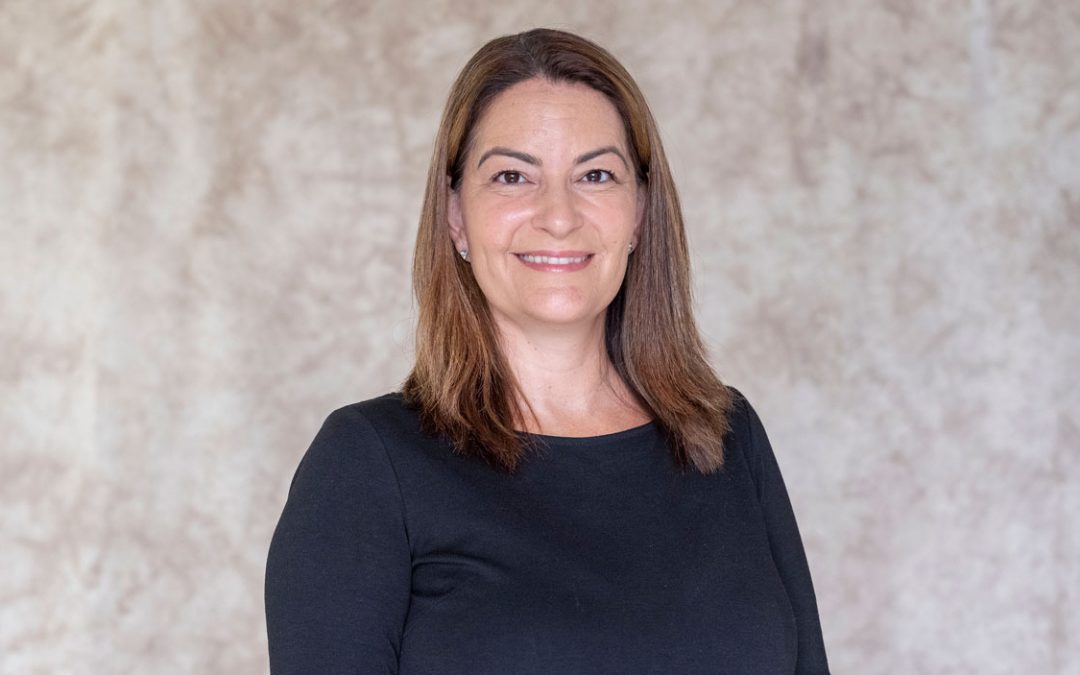
Kiley Bednar, co-director of UMSL’s Community Innovation and Action Center, will help facilitate a yearlong project with the Children’s Funding Project to conduct “fiscal mapping” and analysis of money being spent to support children from cradle to career in a cohort of states. (Photo by August Jennewein)
There are at least 100 sources of federal funds established to assist families and support organizations providing for the well-being of children in the United States.
They come courtesy of government agencies such as the U.S. Departments of Health and Human Services, Agriculture, Education, Labor and even Defense.
Each state layers on even more dollars in an effort to ensure that kids are getting the resources and care they need to be healthy and find success as they grow into adulthood.
But with so many different funding streams flowing into communities through an array of organizations, each offering different services, it’s impossible to know if the money is finding its way to the places it’s needed most and what opportunities are being missed to address the challenges holding children back.
Children’s Funding Project, a national nonprofit organization that assists communities and states in expanding equitable opportunities for children and youth through strategic public financing, is enlisting the help of the Community Innovation and Action Center at the University of Missouri–St. Louis to get a clearer picture of the sources of funding available, where it’s going and how the spending matches up with the needs of people.
Kiley Bednar, CIAC’s co-director, will help facilitate the yearlong project to conduct “fiscal mapping” and analysis of money being spent to support children from cradle to career in a cohort of states. The cohort will include states that cover the gamut in terms of geography and population.
“We often don’t have a clear understanding of how the funding flows, all the way up from the federal dollars down to the specifics of how that plays out locally,” Bednar said. “We don’t fund things just to fund things. We fund things to see change and – at least in the nonprofit sector – to improve the lives of individuals and children and youth. So, we want to know, ‘Are those dollars having the impact that they should?’”
Bednar met Children’s Funding Project Founder CEO Elizabeth Gaines when they worked together at the nonprofit Forum For Youth Investment in Washington, D.C.
Gaines, a native of St. Louis, left the Forum to start Children’s Funding Project in 2018. The organization provides a range of services to help local and state leaders understand the many sources of funding that exist to support programs for children and youth. It also works with advocates to build support for additional services and helps communities plan their long-term funding needs and create sustainable revenue sources.
“I’ve known Kiley for years, so as we thought about who to tap for this new partnership, CIAC was a natural choice,” Gaines said. “Kiley and her team share our perspective about how to make meaningful—and lasting—changes that help kids. I’ve always said, ‘what gets budgeted gets done’ and she understands how that drives our work and the need to educate policymakers about how they fund services for kids. Additionally, since much of our work focuses on the local level, we wanted a group with a strong community connection like the one CIAC has fostered with the city of St. Louis.”
CIAC, home to the St. Louis Regional Data Alliance, proved an ideal partner, having previously completed some fiscal mapping of early childhood funding in the St. Louis region.
Bednar and her team have been seeking to hire a data strategist to lead a team of research associates in designing, managing and executing the fiscal mapping data projects. The strategist will oversee collection, cleaning, analyzing and visualizing of state fiscal data and also help train state partners to conduct the process themselves.
Four graduate research assistants, all from UMSL’s Master of Public Policy Administration Program, including Lacey Robinson, have already started working on the project. She said the work starts with data collection and data cleaning – correcting or removing inaccurate figures – from federal and state funding sources. Then, after pulling that together, they reach out to different budget holders in the community who they’ve determined to be recipients of funding.
“We reach out to them, and we provide them with information on fiscal mapping and provide them also with information on what we found,” said Robinson, who is studying nonprofit management and leadership and local government management in the MPPA program. “‘Here’s what we think is coming to your agency. Can you tell us a little bit about what you’re getting? Can you tell us about the amount? Can you tell us about any additional funding streams?’ We sit down and have a conversation with the budget holders.”
All the information they collect from those conversations is then aggregated so they have a full picture of the total spending.
“It breaks away from that siloed view we have of funding,” Robinson said. “Generally, when we think of funding, we think of who’s getting what piece of the pie and who needs more of the pie. This kind of brings everything thing together and shows the big picture.”
That can help policymakers understand how much funding is coming in, where it’s going and where more is needed. They can then think creatively about how to help build up funds.
The work they’re doing can be applied to many sectors beyond children and youth.
“I think a fiscal map is a really interesting tool to use when it comes to analyzing policy, deciding what is important and what is plausible,” said Wyatt Humrichous, an MPPA student studying local government management. “We have a lot of intersections of economic analysis within fiscal mapping. We have a lot of qualitative data gathered through interviewing as well. So, if you understand policy analysis, then you can certainly understand how a fiscal map would help in that analysis.”
The fiscal maps they create offer a mere snapshot in time. But policymakers and organizational leaders can use them to begin tracking changes in funding over time and compare them to changes in the outcomes they hope to achieve.
“The state maps will go toward creating a more centralized set of standards – this is what this looks like, on average, for a state,” Bednar said. “Then other states can compare their data to what this wider average looks like. You can begin to recognize differences and opportunities for change.”














